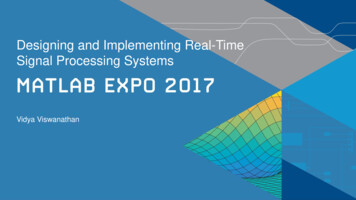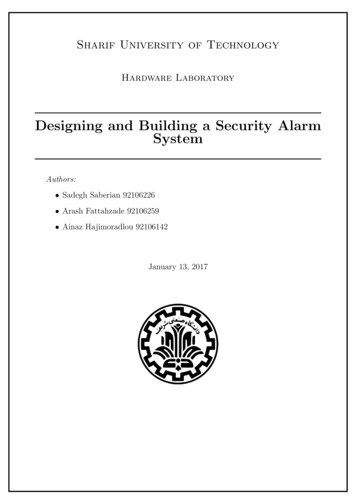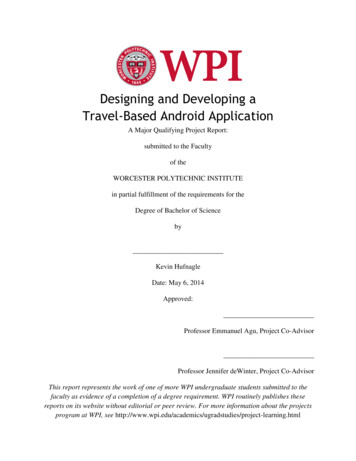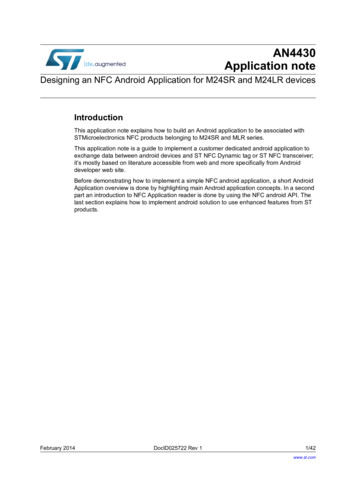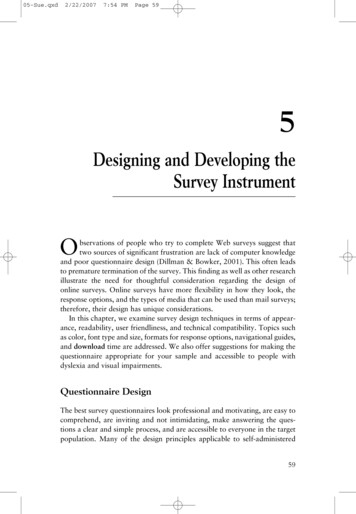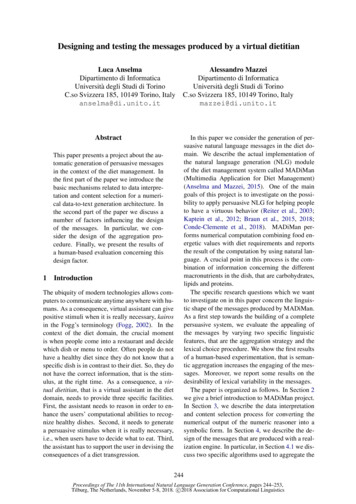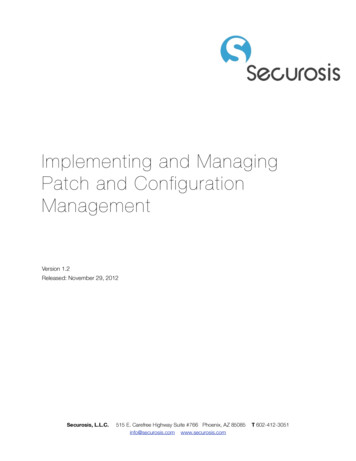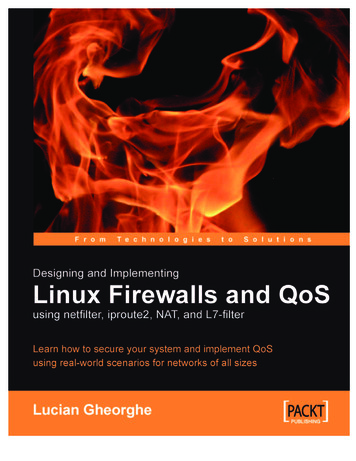
Transcription
Designing and ImplementingLinux Firewalls and QoS usingnetfilter, iproute2, NAT, andL7-filterLearn how to secure your system and implement QoSusing real-world scenarios for networks of all sizesLucian GheorgheBIRMINGHAM - MUMBAI
Designing and Implementing Linux Firewalls and QoSusing netfilter, iproute2, NAT, and L7-filterCopyright 2006 Packt PublishingAll rights reserved. No part of this book may be reproduced, stored in a retrievalsystem, or transmitted in any form or by any means, without the prior writtenpermission of the publisher, except in the case of brief quotations embedded incritical articles or reviews.Every effort has been made in the preparation of this book to ensure the accuracy ofthe information presented. However, the information contained in this book is soldwithout warranty, either express or implied. Neither the author, Packt Publishing,nor its dealers or distributors will be held liable for any damages caused or alleged tobe caused directly or indirectly by this book.Packt Publishing has endeavored to provide trademark information about all thecompanies and products mentioned in this book by the appropriate use of capitals.However, Packt Publishing cannot guarantee the accuracy of this information.First published: October 2006Production Reference: 2181006Published by Packt Publishing Ltd.32 Lincoln RoadOltonBirmingham, B27 6PA, UK.ISBN 1-904811-65-5www.packtpub.comCover Image by www.visionwt.com
CreditsAuthorLucian GheorgheReviewerBarrie DempsterDevelopment EditorLouay FatoohiAssistant Development EditorNikhil BangeraTechnical EditorNiranjan JahagirdarCode TestingAnkur ShahEditorial ManagerDipali ChittarIndexerMithil KulkarniProofreaderChris SmithLayouts and IllustrationsShantanu ZagadeCover DesignerShantanu Zagade
About the AuthorLucian Gheorghe has just joined the Global NOC of Interoute, Europe's largestvoice and data network provider. Before Interoute, he was working as a seniornetwork engineer for Globtel Internet, a significant Internet and Telephony ServicesProvider to the Romanian market. He has been working with Linux for more than8 years putting a strong accent on security for protecting vital data from hackersand ensuring good quality services for internet customers. Moving to VoIP serviceshe had to focus even more on security as sensitive billing data is most often storedon servers with public IP addresses. He has been studying QoS implementationson Linux to build different types of services for IP customers and also to delivergood quality for them and for VoIP over the public Internet. Lucian has also beenprogramming with Perl, PHP, and Smarty for over 5 years mostly developingin-house management interfaces for IP and VoIP services.I would like to thank everyone who is reading this book andthe people that run netfilter, iproute2, and L7-filter projects.Your feedback is very important to me, so drop me a line atlucian.firewallbook@gmail.com. The book is far from beingperfect so please send me errata information on the same emailaddress (I would love to receive erratas from readers because itwill convince me that people who read this book actuallylearned something :-))I want to dedicate this book to my father, my mother, and mysister—I love you very very much. Many thanks go to the team atGlobtel who were like second family to me, to my girlfriend forunderstanding me and standing by me, to Louay and the rest of theteam at Packt Publishing for doing a great job, to Nigel Coulson,Petr Klobasa and the rest of the people at Interoute for supportingme, to Claudiu Filip who is one of the most intelligent people Iknow, and last, but not least, to the greatest technical authoralive—Cristian Darie.
About the ReviewerBarrie Dempster is currently employed as a Senior Security Consultant forNGS Software Ltd, a world-renowned security consultancy well known for itsfocus in enterprise-level application vulnerability research and database security.He has a background in Infrastructure and Information Security in a number ofspecialized environments such as financial services institutions, telecommunicationscompanies, call centers, and other organizations across multiple continents. Barriehas experience in the integration of network infrastructure and telecommunicationssystems requiring high-caliber secure design, testing, and management. He has beeninvolved in a variety of projects from the design and implementation of Internetbanking systems to large-scale conferencing and telephony infrastructure, as well aspenetration testing and other security assessments of business-critical infrastructure.
Table of ContentsPrefaceChapter 1: Networking FundamentalsThe OSI ModelOSI Layer 7: ApplicationOSI Layer 6: PresentationOSI Layer 5: SessionOSI Layer 4: TransportOSI Layer 3: NetworkOSI Layer 2: Data LinkOSI Layer 1: PhysicalOSI Functionality Example and BenefitsThe TCP/IP ModelThe TCP/IP Application LayerThe TCP/IP Transport LayerThe Transmission Control Protocol (TCP)The User Datagram Protocol (UDP)178991010111111121313141518The TCP/IP Internet Layer19The TCP/IP Network Access Layer22TCP/IP Protocol Suite Summary23OSI versus TCP/IP 25IP Addressing, IP Subnetting, and IP Supernetting 27Obtaining an IP Address28IP Classes29Reserved IP AddressesPublic and Private IP Addresses3031IP Subnetting32IP Supernetting or CIDR36The Subnet MaskEverything Divided in TwoA Different Approach333436
Table of ContentsHow the Internet Works 38Summary 39Chapter 2: Security Threats41Chapter 3: Prerequisites: netfilter and iproute263Layer 1 Security ThreatsLayer 2 Security ThreatsMAC AttacksDHCP AttacksARP AttacksSTP and VLAN-Related AttacksLayer 3 Security ThreatsPacket SniffingIP SpoofingRouting Protocols AttacksICMP AttacksTeardrop AttacksLayer 4 Security ThreatsTCP AttacksUDP AttacksTCP and UDP Port Scan AttacksLayer 5, 6, and 7 Security ThreatsBIND Domain Name System (DNS)Apache Web ServerVersion Control SystemsMail Transport Agents (MTA)Simple Network Management Protocol (SNMP)Open Secure Sockets Layer (OpenSSL)Protect Running Services—General DiscussionSummarynetfilter/iptablesIptables — OperationsFiltering SpecificationsTarget SpecificationsA Basic Firewall Script—Linux as a 354555656626367687072iproute2 and Traffic ControlNetwork Configuration: "ip" ToolTraffic Control: tc747475tc qdisc, tc class, and tc filter80Queuing Packets76A Real Example82Summary86[ ii ]
Table of ContentsChapter 4: NAT and Packet Mangling with iptablesA Short Introduction to NAT and PAT (NAPT)SNAT and MasqueradeDNATFull NAT (aka Full Cone NAT)PAT or NAPTNAT Using iptablesSetting Up the KernelThe netfilter nat TableSNAT with iptablesDNAT with iptablesTransparent ProxySetting Up the ScriptVerifying the ConfigurationA Less Normal Situation: Double NATPacket Mangling with iptablesThe netfilter mangle 13115117Chapter 5: Layer 7 Filtering119Chapter 6: Small Networks Case Studies137When to Use L7-filterHow Does L7-filter Work?Installing L7-filterApplying the Kernel PatchApplying the iptables PatchProtocol DefinitionsTesting the InstallationL7-filter ApplicationsFiltering Application DataApplication Bandwidth LimitingAccounting with L7-filterIPP2P: A P2P Match OptionInstalling IPP2PUsing IPP2PIPP2P versus 32132133134135Linux as SOHO RouterSetting Up the NetworkDefining the Security PolicyBuilding the Firewall[ iii ]137139141142
Table of ContentsSetting Up the Firewall ScriptVerifying the Firewall ConfigurationQoS—Bandwidth Allocation146147150The QoS ScriptVerifying the QoS Configuration151152Linux as Router for a Typical Small to Medium CompanySetting Up the RouterDefining the Security PolicyA Few Words on ApplicationsCreating the Firewall RulesSetting Up the Firewall ScriptQoS—Bandwidth Allocation154154156156158161163Summary168The QoS ScriptChapter 7: Medium Networks Case StudiesExample 1: A Company with Remote LocationsThe NetworkBuilding the Network ConfigurationDesigning the FirewallsBuilding the FirewallsSites B and CSite AHeadquartersMake the Network Intelligent by Adding QoSExample 2: A Typical Small ISPThe NetworkBuilding the Network ConfigurationDesigning and Implementing the FirewallsThe Intranet Server: 1.2.3.10The Wireless Server: 1.2.3.130The AAA Server: 1.2.3.1The Database Server: 1.2.3.2The Email Server: 1.2.3.3The Web Server: 1.2.3.4A Few Words on the Access Server: 1.2.3.131The Core Router—First Line of DefenseQoS for This NetworkQoS on the Wireless Server for Long-Range Wireless UsersQoS on the Intranet Server for the Internal DepartmentsQoS on the Core 5196200201203205206208208214216218220Summary 224[ iv ]
Table of ContentsChapter 8: Large Networks Case Studies 225Thinking Large, Thinking Layered Models 228A Real Large Network Example 229A Brief Network Overview230City-1City-2City-3 and City-4231232234The Core Network Configuration235Security Threats242City-1 Firewall for Business-Critical Voice Equipment250QoS Implementation255Core-2Core-1, Core-3, and Core-4237240Core Routers INPUT FirewallsProtecting the Networks behind the Core RoutersDenial of Service AttacksSecuring the Voice NetworkTraffic Shaping for Clients242243245252260Summary 263Index265[ ]
PrefaceA networking firewall is a logical barrier designed to prevent unauthorizedor unwanted communications between sections of a computer network.Linux-based firewalls besides being highly customizable and versatile are alsorobust, inexpensive, and reliable.The two things needed to build firewalls and QoS with Linux are two packagesnamed netfilter and iproute. While netfilter is a packet-filtering framework includedin the Linux kernels 2.4 and 2.6, iproute is a package containing a few utilities thatallow Linux users to do advanced routing and traffic shaping.L7-filter is a packet classifier for the Linux kernel that doesn't look up port numbersor Layer 4 protocols, but instead looks at the data in an IP packet and does a regularexpression match on it to determine what kind of data it is, mainly what applicationprotocol is being used. IP2P is an alternative to L7-filter, but has been designed forfiltering only P2P applications while L7-filter takes into consideration a wider rangeof applications.What This Book CoversChapter 1 is a brief introduction to networking concepts. It covers the OSI and TCP/IP networking models with explanations of their layers, TCP and UDP as Layer4 protocols, and then rounds off the chapter with a discussion on IP addresses,Subnetting, and Supernetting.Chapter 2 discusses possible security threats and vulnerabilities found at each of theOSI layers. The goal here is to understand where and how these threats can affect usand to stay protected from attackers. It then rounds off the discussion by sketchingout the basic steps required to protect the services that run on our system.
PrefaceChapter 3 introduces two tools needed to build Linux firewalls and QoS. We firstlearn the workings of netfilter, which is a packet-filtering framework, and implementwhat we have learned to build a basic firewall for a Linux workstation. We thensee how to perform advanced routing and traffic shaping using the IP and TC toolsprovided by the iproute2 package. The chapter ends with another example scenariowhere we implement the concepts learned in the chapter.Chapter 4 discusses NAT, the types of NAT, how they work, and how they canbe implemented with Linux by giving practical examples. It also describe packetmangling, when to use it, and why to use it.Chapter 5 covers Layer 7 filtering in detail. We see how to install the L7-filter package,apply the necessary Linux kernel and iptables patches, and test our installation. Wethen learn the different applications of L7-filter and see how to put them to practicaluse. We also see how to install and use IPP2P, which is an alternative to theL7-filter package, but only for P2P traffic, and finally we set up a test between thetwo packages.Chapter 6 raises two very popular scenarios, for which we design, implement, andtest firewalls and a small QoS configuration. In the first scenario, we configure Linuxas a SOHO router. Being a relatively smaller network with few devices, we learnhow to adapt to what we have learned in the earlier chapters to suit this environmentand build a secure network. We implement transparent proxies using squid andiptables so that children/minors cannot access malicious or pornographic webcontent. Our firewall setup implements NAT to redirect traffic from certain ports toother hosts using Linux. This configuration is tested by checking the NAT table andseeing how the kernel analyzes our rules.As part of QoS, we split the bandwidth between the devices in a SOHO environmentusing HTB. Assuming a 1Mbps connection, we design a policy to split it between the4 devices creating 4 HTB child classes for the 4 devices. In the end, we test our QoSconfiguration using the tc class show command.In the second scenario, we configure Linux as router for a typical small tomedium company.Chapter 7 covers the design of a firewall system for a hypermarket having itsheadquarters in one location, one store in the same city, and several stores in othercities. The hypermarket has an application that uses MSSQL databases in eachlocation, which are replicated at the headquarters. All locations have IP AnalogTelephone Adapters with subscriptions at the main provider (the HQ provider). Inthis example we use, just like in the real H.323 as the VoIP protocol. We set up allremote locations to have an encrypted VPN connection using ip tunnel to connectto the headquarters. Users are shown how to create a QOS script with HTB thatcontrols bandwidth usage based on priorities.[ ]
PrefaceThe next firewall taken up is that for a small ISP setup that has one internetconnection, an access network, a server farm, and the internal departments. Thesetup of firewall scripts for each of them and methods to handle the tricky wirelessserver are covered. The QoS is handled by the intranet server, the wireless server,and the Core router.Chapter 8 covers the design of a three-layered network deployed at a large providerof Internet and IP telephony services, the three layers being Core, Distribution, andAccess. It explains network configuration first on the core and distribution levels andthen moves on to building firewalls. The huge size of the network also means thatthere is a need to tackle newer security threats. We have four Cores running BGPunder Zebra and each one is peculiar in its own way. There are three data servicesthat this ISP can provide to its customers: Internet access, national network access,and metropolitan network access. This chapter will show you how to handle QoS soas to limit this traffic as needed.ConventionsIn this book, you will find a number of styles of text that distinguish betweendifferent kinds of information. Here are some examples of these styles, and anexplanation of their meaning.There are three styles for code. Code words in text are shown as follows: "To limitupload, we will mark packets in the PREROUTING chain of the mangle table".A block of code will be set as follows:#Drop SSH packets except from admins IPT -A INPUT -s ! 1.2.3.16/28 -p tcp --dport 22 -j DROPWhen we wish to draw your attention to a particular part of a code block, therelevant lines or items will be made bold:tc filter add dev eth0 protocol ip parent 1:0 prio 5 u32 match ip src1.2.3.34 flowid 1:100New terms and important words are introduced in a bold-type font. Words thatyou see on the screen, in menus or dialog boxes for example, appear in our text likethis: "In the IP: Netfilter Configuration section you will find the options neededfor NAT".[ ]
PrefaceWarnings or important notes appear in a box like this.Tips and tricks appear like this.Reader FeedbackFeedback from our readers is always welcome. Let us know what you think aboutthis book, what you liked or may have disliked. Reader feedback is important for usto develop titles that you really get the most out of.To send us general feedback, simply drop an email to feedback@packtpub.com,making sure to mention the book title in the subject of your message.If there is a book that you need and would like to see us publish, please send us anote in the SUGGEST A TITLE form on www.packtpub.com or email suggest@packtpub.com.If there is a topic that you have expertise in and you are interested in either writingor contributing to a book, see our author guide on www.packtpub.com/authors.Customer SupportNow that you are the proud owner of a Packt book, we have a number of things tohelp you to get the most from your purchase.Downloading the Example Code for the BookVisit http://www.packtpub.com/support, and select this book from the list of titlesto download any example code or extra resources for this book. The files availablefor download will then be displayed.The downloadable files contain instructions on how to use them.[ ]
PrefaceErrataAlthough we have taken every care to ensure the accuracy of our contents, mistakesdo happen. If you find a mistake in one of our books—maybe a mistake in text orcode—we would be grateful if you would report this to us. By doing this you cansave other readers from frustration, and help to improve subsequent versions of thisbook. If you find any errata, report them by visiting http://www.packtpub.com/support, selecting your book, clicking on the Submit Errata link, and entering thedetails of your errata. Once your errata have been verified, your submission will beaccepted and the errata added to the list of existing errata. The existing errata can beviewed by selecting your title from http://www.packtpub.com/support.QuestionsYou can contact us at questions@packtpub.com if you are having a problem withsome aspect of the book, and we will do our best to address it.[ ]
Networking FundamentalsWhen it comes to theory, some of you out there might find it boring to read; so the firstthing that may go through your mind is to skip this chapter. Don't do it. Even if youthink that you know all the theoretical concepts, a recapitulation is good anytime.Network professionals talk about protocols, devices, and software in terms of whichOSI Layer they function at. When people talk about high-performance Layer 3switches these days, they talk about switches that can perform OSI Layer 3 tasks andthey expect you to know which tasks are at that layer. A simple deduction makesyou realize that classic switches perform OSI Layer 2 functions.Layer 3 switches are beyond the scope of this book, but that was a simple example ofwhy you should know the OSI layered model, which is purely theoretical. Further inthis book, you will learn about "Layer 7 filtering" which refers to how to filter what ison OSI Layer 7, which I'm sure you will find very attractive to read and implement.By definition, a network is a group of two or more computer systems linked together,with the ability to communicate with each other.The types of networks commonly used are: LAN (Local Area Network): A network in which the computers are closetogether (the same building). WAN (Wide Area Network): A network in which the computers are at verylong distances. MAN (Metropolitan Area Network): A city-wide network. CAN (Campus Area Network): A network in a campus or a military base. SAN (Storage Area Network): A high-performance network used to movedata between servers and dedicated storage devices. VPN (Virtual Private Network): A private network built over the publicnetwork infrastructure (over the Internet).
Networking Fundamentals HAN (Home Area Network): A network in a personal home. This term israrely used; most people use the term LAN in this matter.Computers in a user home network (a HAN) are usually connected to the buildingswitch and form a LAN with the other us
The two things needed to build firewalls and QoS with Linux are two packages named netfilter and iproute. While netfilter is a packet-filtering framework included in the Linux kernels 2.4 and 2.6, iproute is a package containing a few utilities that allo
